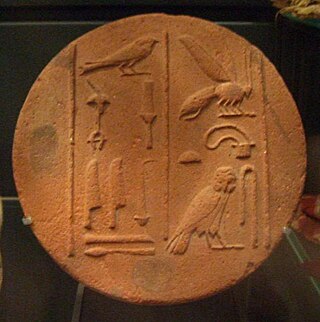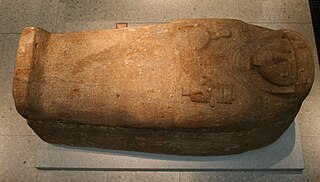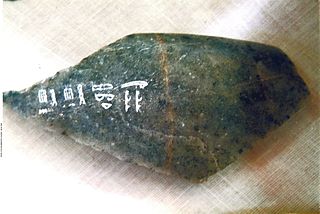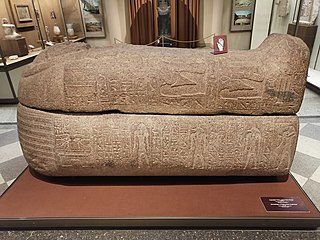
Memphis, or Men-nefer, was the ancient capital of Inebu-hedj, the first nome of Lower Egypt that was known as mḥw ("North"). Its ruins are located in the vicinity of the present-day village of Mit Rahina, in markaz (county) Badrashin, Giza, Egypt. This modern name is probably derived from the late Ancient Egyptian name for Memphis mjt-rhnt meaning "Road of the Ram-Headed Sphinxes".

Ptah is an ancient Egyptian deity, a creator god and patron deity of craftsmen and architects. In the triad of Memphis, he is the husband of Sekhmet and the father of Nefertem. He was also regarded as the father of the sage Imhotep.
Prince Khaemweset was the fourth son of Ramesses II and the second son by his queen Isetnofret. His contributions to Egyptian society were remembered for centuries after his death. Khaemweset has been described as "the first Egyptologist" due to his efforts in identifying and restoring historic buildings, tombs and temples.

Isetnofret was one of the Great Royal Wives of Pharaoh Ramesses II and was the mother of his successor, Merneptah. She was one of the most prominent of the royal wives, along with Nefertari, and was the chief queen after Nefertari's death.

The High Priest of Ptah was sometimes referred to as "the Greatest of the Directors of Craftsmanship". This title refers to Ptah as the patron god of the craftsmen.

Ptahemhat called Ty was High Priest of Ptah in Memphis during the time of 18th Dynasty reign of Tutankhamen and/or Ay.
Sabu called Kem was High Priest of Ptah, probably during the reign of Pepi I. His precise titles include greatest of the directors of craftsmen belonging to the day of the festival of the Sun, priest of Sokar in the two houses and priest of Ptah.

Pahemnetjer(p3-ḥm-nṯr; "servant of the god", "priest") was a High Priest of Ptah during the reign of Ramesses II. Pahemnetjer succeeded Huy as High Priest of Ptah and was in turn succeeded by his son Didia.
Didia was High Priest of Ptah during the reign of Ramesses II. Didia succeeded his father Pahemnetjer into the office of High Priest of Ptah.
Ranefer or Ranofer was a High Priest of Ptah, who lived at the beginning of the Fifth Dynasty of Ancient Egypt. His name means "Ra is beautiful". His main title was "greatest of the directors of craftsmen belonging to the day of festival". This is a variation of the title normally assigned to the high priest of Ptah.

Shoshenq was a High Priest of Ptah during the 22nd Dynasty. Shoshenq was the eldest son of Osorkon II and Queen Karomama. He presided over the burial of the twenty-seventh Apis bull in Saqqara. For unknown reasons Shoshenq did not succeed to his father's throne and was buried in Memphis when Shoshenq III was king of Egypt. Shoshenq's tomb was found unplundered in 1942.

Hori was the High Priest of Ptah at the very end of the reign of Ramesses II. Hori succeeded Neferronpet in office.
Ptahmose was High Priest of Ptah in Memphis during the time of Thutmose IV and in the beginning of the reign of Amenhotep III.

Sehetepebreankh-nedjem was an ancient Egyptian official with the titles royal sealer, foremost of action, Sem-priest and Great one of the leaders of craftsmen. The latter title is that of the High Priest of Ptah. The god Ptah was the deity of arts and crafts and therefore, the high priest of Ptah had a title related to crafts. Sehetepebreankh-nedjem is known from a group statue showing him, his son and his grandson. The statue was dedicated by his son Nebpu, who was also High Priest of Ptah. The statue is datable by style to the end of the Twelfth Dynasty and is now in the Louvre. The statue was bought in 1816 by the Louvre and is most likely from Memphis. This city was the major cult centre for Ptah.

The ancient Egyptian noble Prehotep II was Vizier in the latter part of the reign of Ramesses II, during the 19th Dynasty.

Pasherienptah (III)(p3-šrỉ-n-ptḥ, 'Son of Ptah'; November 4, 90 BCE – July 13 or 14, 41 BCE) was an ancient Egyptian high Priest of Ptah in Memphis from 76 BCE until his death. Two of his stelas are known, the one with a hieroglyphic inscription is in the Ashmolean Museum (Ash. M. 1971/18), the other, Demotic stela, of which only seven fragments have been found, is in the British Museum (BM 886).

Pehen-Ptah was an ancient Egyptian high official, sculptor and maker of vases during the 2nd Dynasty or early 3rd Dynasty. It is disputed as to who was the king reigning during Pehen-Ptah's time of officeship.

The Genealogy of Ankhefensekhmet or Genealogy of the Memphite priestly elite is an ancient Egyptian relief – sometimes referred to as a stela – normally identified as having been made during the 8th century BCE, under the reign of pharaoh Shoshenq V of the late 22nd Dynasty. A surviving block is kept at the Egyptian Museum of Berlin. The relief was issued by a priest called Ankhefensekhmet with the purpose of illustrating his own genealogy. The relief traces back Ankhefensekhmet's sequence of ancestors up to 64 generations before, with the earliest individual, Ptahemheb, identified by Ritner as being from the time of Nebhepetre of the 11th Dynasty and alternatively identified by Borchart as being from the time of Nebkaure Khety of the 10th Dynasty. On 25 occasions the genealogy also names the pharaoh or king who was ruling at the time.
Ptah is a god in Egyptian mythology.

Nakhy was an Ancient Egyptian priest in the function of a High Priest of Ptah, who lived most likely in the 19th Dynasty.













